Enhancing Watershed Management Through the Characterization of the River Restoration Index (RRI): A Case Study of the Samian Watershed, Ardabil Province, Iran
Abstract
1. Introduction
2. Materials and Methods
2.1. Case Study Description
2.2. Data Used
2.3. Sub-Indices Calculation
2.3.1. The General State of the Watershed (GSW)
Permeability ()
Sanitation Conditions ()
Urban Occupation of the Riverbanks ()
2.3.2. Connectivity (Con)
Transversal Connectivity ()
Longitudinal Connectivity ()
- (1)
- The interest watershed is upstream of the dam, as a result of which equals one, because the dam does not affect the interest area;
- (2)
- The interest watershed coincides with the dam watershed, which leads to being equal to zero, because it represents a wholly altered watershed;
- (3)
- The studied watershed area is larger than that demarcated by the dam and the consequence of the dam on the downstream reaches its minimum value by moving away from the upstream areas.
Vertical Connectivity ()
2.3.3. Riverbank Conditions (RbC)
Riparian Vegetation ()
Urban Occupation of the Riverbanks ()
2.3.4. Hydraulic Risk Reduction (HRR)
2.4. River Restoration Index (RRI)
2.5. Weight Determination
- -
- Step 1: Decision matrix building
- -
- Step 2: Normalization
- -
- Step 3: Calculating the overall performance of the options (Si)
- -
- Step 4: Calculating the performance of options by removing the effects of criteria (S′)
- -
- Step 5: Calculating the sum of absolute deviations (E)
- -
- Step 6: Calculating the final weights (W)
2.6. Sub-Watersheds Ranking
- -
- Step 1: Projection of distances between sub-watersheds (d (0, mk))
- R = 1 d″: weighted arithmetic mean;
- R = −1 d″: geometric mean;
- R = 2 d″: mean square;
- R = −∞ d″: min (r_k, r_k (m));
- R = +∞ d″: max (r_k, r_k (m)).
- -
- Step 2: Overall ranking of distances, rk(m)
- -
- Step 3: Aggregation
3. Results
3.1. The General State of the Watershed (GSW)
3.2. Connectivity (Con)
3.3. Riverbank Conditions (RbC)
3.4. Hydraulic Risk Reduction (HRR)
3.5. Criteria and Sub-Indices Weighting
3.6. Sub-Watersheds Zoning and Ranking Based on the RRI and Its Sub-Indices
4. Discussion
5. Conclusions
Author Contributions
Funding
Data Availability Statement
Acknowledgments
Conflicts of Interest
Appendix A
| Data Used | Source |
|---|---|
| Discharge data | Regional Water Company of Ardabil (http://arrw.ir/?l=EN, accessed on 29 April 2024) |
| Waste collection and disposal systems | Statistics Center of Iran [23] (https://old.sci.org.ir/english/Population-and-Housing-Censuses, accessed on 29 April 2024) |
| Rainfall | https://www.irimo.ir/eng/index.php, accessed on 29 April 2024 |
| Floodplain map | https://gisacademy.ir/shop/gis-data/ardabil-province-dataset/, accessed on 6 May 2024 |
| Land use | Moradzadeh et al. [21] |
| River shape file | https://gisacademy.ir/shop/gis-data/ardabil-province-dataset/, accessed on 6 May 2024 |
| Topography map | Iran National Cartographic Center (https://en.ncc.gov.ir/, accessed on 6 May 2024) |
| Soil map | General Directorate of Natural Resources and Watershed Management of Ardabil Province (https://ardabil.frw.ir/, accessed on 6 May 2024) |
| Slope | https://gisacademy.ir/shop/gis-data/ardabil-province-dataset/, accessed on 6 May 2024 |
| Dam frequency | Country Planning and Budget Organization [22]; http://www.arrw.ir/st/419, accessed on 29 April 2024 |
| Sub-Watershed No. | Sub-Criteria | Criteria | Sub-Criteria | Criteria | ||
|---|---|---|---|---|---|---|
| Permeable Area (km2) | Total Area (km2) | Permeability | Area Served by Treatment/Disposal (km2) | Total Area (km2) | Sanitation Conditions | |
| 1 | 76.81 | 186.71 | 0.41 | 0.90 | 186.71 | 0.005 |
| 2 | 25.87 | 61.48 | 0.42 | 0.30 | 61.48 | 0.005 |
| 3 | 27.68 | 56.10 | 0.49 | 0.27 | 56.10 | 0.005 |
| 4 | 20.61 | 48.27 | 0.43 | 0.23 | 48.27 | 0.005 |
| 5 | 13.74 | 51.75 | 0.27 | 0.25 | 51.75 | 0.005 |
| 6 | 145.52 | 262.26 | 0.55 | 1.27 | 262.26 | 0.005 |
| 7 | 58.37 | 132.16 | 0.44 | 0.64 | 132.16 | 0.005 |
| 8 | 229.47 | 348.10 | 0.66 | 1.68 | 348.10 | 0.005 |
| 9 | 100.01 | 157.11 | 0.60 | 0.76 | 157.11 | 0.005 |
| 10 | 158.26 | 215.49 | 0.74 | 1.04 | 215.49 | 0.005 |
| 11 | 70.89 | 189.71 | 0.37 | 0.91 | 189.71 | 0.005 |
| 12 | 2.64 | 130.20 | 0.02 | 0.63 | 130.20 | 0.005 |
| 13 | 76.96 | 225.72 | 0.34 | 1.09 | 225.72 | 0.005 |
| 14 | 114.09 | 224.29 | 0.51 | 1.08 | 224.29 | 0.005 |
| 15 | 81.80 | 325.68 | 0.25 | 1.57 | 325.68 | 0.005 |
| 16 | 14.07 | 55.54 | 0.25 | 0.27 | 55.54 | 0.005 |
| 17 | 31.16 | 189.25 | 0.17 | 0.91 | 189.25 | 0.005 |
| 18 | 87.98 | 228.10 | 0.39 | 1.10 | 228.10 | 0.005 |
| 19 | 4.05 | 71.20 | 0.06 | 0.34 | 71.20 | 0.005 |
| 20 | 0.00 | 62.34 | 0.00 | 0.30 | 62.38 | 0.005 |
| 21 | 3.40 | 74.43 | 0.05 | 0.36 | 74.438 | 0.005 |
| 22 | 4.03 | 327.32 | 0.01 | 1.58 | 327.32 | 0.005 |
| 23 | 0.00 | 92.97 | 0.00 | 0.45 | 92.96 | 0.005 |
| 24 | 71.91 | 248.72 | 0.29 | 1.20 | 248.72 | 0.005 |
| 25 | 1.33 | 75.39 | 0.02 | 0.36 | 75.39 | 0.005 |
| 26 | 3.54 | 44.29 | 0.08 | 0.21 | 44.29 | 0.005 |
| 27 | 0.94 | 150.99 | 0.01 | 0.73 | 150.99 | 0.005 |
| Total | 1425.08 | 4235.58 | 0.34 | 20.43 | 4235.58 | 0.01 |
| Sub-Watershed No. | Sub-Criteria | Criteria | Sub-Criteria | Criteria | Sub-Criteria | Criteria | |||
|---|---|---|---|---|---|---|---|---|---|
| Length of Riverbanks Connected to the Floodplain )m) | Total Length of Riverbanks (m) | Transversal Connectivity | Watershed Area (km2) | Area Defined by a Longitudinal Barrier (km2) | Longitudinal Connectivity | Length of Riverbanks and Riverbed in a Natural State (m) | Total Length of Riverbanks and Riverbed (m) | Vertical Connectivity | |
| 1 | 0.00 | 77,950.79 | 0.00 | 186.71 | 0.00 | 1.00 | 77,950.79 | 77,950.79 | 1.00 |
| 2 | 0.00 | 22,483.77 | 0.00 | 61.48 | 0.00 | 1.00 | 22,483.77 | 22,483.77 | 1.00 |
| 3 | 0.00 | 21,608.30 | 0.00 | 56.10 | 0.00 | 1.00 | 21,608.30 | 21,608.30 | 1.00 |
| 4 | 0.00 | 27,386.17 | 0.00 | 48.27 | 0.00 | 1.00 | 27,386.17 | 27,386.17 | 1.00 |
| 5 | 0.00 | 30,835.43 | 0.00 | 51.75 | 0.00 | 1.00 | 30,835.43 | 30,835.43 | 1.00 |
| 6 | 0.00 | 124,131.53 | 0.00 | 262.26 | 1.90 | 1.00 | 124,109.22 | 124,131.53 | 0.99 |
| 7 | 0.00 | 38,622.17 | 0.00 | 132.16 | 0.00 | 1.00 | 38,622.17 | 38,622.17 | 1.00 |
| 8 | 0.00 | 166,965.71 | 0.00 | 348.10 | 41.10 | 0.88 | 166,952.79 | 166,965.71 | 0.99 |
| 9 | 0.00 | 82,010.95 | 0.00 | 157.11 | 0.00 | 1.00 | 82,010.95 | 82,010.95 | 1.00 |
| 10 | 0.00 | 71,905.90 | 0.00 | 215.49 | 0.00 | 1.00 | 71,905.90 | 71,905.90 | 1.00 |
| 11 | 0.00 | 120,111.06 | 0.00 | 189.71 | 0.50 | 0.98 | 120,100.84 | 120,111.06 | 0.99 |
| 12 | 0.00 | 36,819.67 | 0.00 | 130.20 | 0.80 | 0.10 | 36,812.05 | 36,819.67 | 0.99 |
| 13 | 0.00 | 92,863.73 | 0.00 | 225.72 | 0.00 | 1.00 | 92,863.73 | 92,863.73 | 1.00 |
| 14 | 0.00 | 48,896.10 | 0.00 | 224.29 | 1.10 | 0.99 | 48,879.16 | 48,896.10 | 0.99 |
| 15 | 0.00 | 125,882.99 | 0.00 | 325.68 | 13.80 | 0.96 | 125,810.36 | 125,882.99 | 0.99 |
| 16 | 1.99 | 29,563.56 | 6.74 | 55.54 | 0.00 | 1.00 | 29,563.56 | 29,563.56 | 1.00 |
| 17 | 0.00 | 75,554.85 | 0.00 | 189.25 | 1.80 | 0.99 | 75,544.19 | 75,554.85 | 0.99 |
| 18 | 0.00 | 97,197.01 | 0.00 | 228.10 | 0.00 | 1.00 | 97,197.01 | 97,197.01 | 1.00 |
| 19 | 2.00 | 16,431.30 | 0.00 | 71.20 | 0.00 | 1.00 | 16,431.30 | 16,431.30 | 1.00 |
| 20 | 2.01 | 24,946.54 | 8.04 | 62.38 | 0.00 | 1.00 | 24,946.54 | 24,946.54 | 1.00 |
| 21 | 1.25 | 24,554.50 | 5.09 | 74.43 | 0.00 | 1.00 | 24,554.50 | 24,554.50 | 1.00 |
| 22 | 2.00 | 55,910.75 | 3.57 | 327.32 | 13.6 | 0.96 | 55,881.46 | 55,910.75 | 0.99 |
| 23 | 0.00 | 41,970.62 | 0.00 | 92.95 | 0.00 | 1.00 | 41,970.62 | 41,970.62 | 1.00 |
| 24 | 0.00 | 154,903.53 | 0.00 | 248.72 | 12.1 | 0.95 | 154,861.35 | 154,903.53 | 0.99 |
| 25 | 2.01 | 21,774.00 | 9.21 | 75.39 | 2.90 | 0.96 | 21,757.91 | 21,774.00 | 0.99 |
| 26 | 0.00 | 16,413.74 | 0.00 | 44.29 | 0.00 | 1.00 | 16,413.74 | 16,413.74 | 1.00 |
| 27 | 2.02 | 39,734.49 | 5.07 | 150.99 | 3.90 | 0.97 | 39,657.96 | 39,734.49 | 0.99 |
| Total | 1.80 | 1,687,429.16 | 1.07 | 4235.58 | 93.50 | 25.76 | 1,687,111.78 | 1,687,429.16 | 0.99 |
| Sub-Watershed No. | Sub-Criteria | Criteria | Sub-Criteria | Criteria | ||
|---|---|---|---|---|---|---|
| Sum Length of the Riparian Vegetation (m) | Total Length of the Riverbanks (m) | Riparian Vegetation | Length of the Urban Occupation of Riverbanks (m) | Total Length of Riverbanks (m) | Urban Occupation of the Riverbanks | |
| 1 | 34,658.84 | 77,950.79 | 0.45 | 26.38 | 77,950.79 | 0.00 |
| 2 | 10,418.25 | 22,483.77 | 0.45 | 0.00 | 22,483.77 | 0.00 |
| 3 | 13,257.16 | 21,608.30 | 0.62 | 0.00 | 21,608.30 | 0.00 |
| 4 | 5218.49 | 27,386.17 | 0.20 | 3.74 | 27,386.17 | 0.00 |
| 5 | 6484.67 | 30,835.43 | 0.22 | 394.52 | 30,835.43 | 0.01 |
| 6 | 41,374.84 | 124,131.53 | 0.34 | 4425.41 | 124,131.53 | 0.04 |
| 7 | 15,247.48 | 38,622.17 | 0.40 | 252.53 | 38,622.17 | 0.01 |
| 8 | 90,105.94 | 166,965.71 | 0.54 | 1894.27 | 166,965.71 | 0.01 |
| 9 | 48,548.93 | 82,010.95 | 0.59 | 294.96 | 82,010.95 | 0.00 |
| 10 | 50,170.62 | 71,905.90 | 0.70 | 711.30 | 71,905.90 | 0.01 |
| 11 | 35,186.66 | 120,111.06 | 0.29 | 1831.01 | 120,111.06 | 0.02 |
| 12 | 0.00 | 36,819.67 | 0.00 | 958.59 | 36,819.67 | 0.03 |
| 13 | 22,787.10 | 92,863.73 | 0.25 | 234.22 | 92,863.73 | 0.00 |
| 14 | 28,748.72 | 48,896.10 | 0.59 | 160.85 | 48,896.10 | 0.00 |
| 15 | 31,015.06 | 125,882.99 | 0.25 | 3488.72 | 125,882.99 | 0.03 |
| 16 | 4125.14 | 29,563.56 | 0.14 | 0.00 | 29,563.56 | 0.00 |
| 17 | 10,148.66 | 75,554.85 | 0.13 | 220.94 | 75,554.85 | 0.00 |
| 18 | 35,954.50 | 97,197.01 | 0.37 | 3961.82 | 97,197.01 | 0.04 |
| 19 | 0.00 | 16,431.30 | 0.01 | 279.60 | 16,431.30 | 0.02 |
| 20 | 0.00 | 24,946.54 | 0.01 | 992.84 | 24,946.54 | 0.04 |
| 21 | 0.00 | 24,554.50 | 0.01 | 6273.39 | 24,554.50 | 0.26 |
| 22 | 0.00 | 55,910.75 | 0.01 | 474.58 | 55,910.75 | 0.01 |
| 23 | 0.00 | 41,970.62 | 0.01 | 2701.30 | 41,970.62 | 0.06 |
| 24 | 47,718.76 | 154,903.53 | 0.31 | 1049.02 | 154,903.53 | 0.01 |
| 25 | 0.00 | 21,774.00 | 0.00 | 0.00 | 21,774.00 | 0.00 |
| 26 | 0.00 | 16,413.74 | 0.00 | 0.00 | 16,413.74 | 0.00 |
| 27 | 0.00 | 39,734.49 | 0.00 | 12,288.47 | 39,734.49 | 0.31 |
| Total | 531,169.79 | 1,687,429.16 | 0.32 | 42,918.48 | 1,687,429.16 | 0.025 |
| Sub-Watershed No. | Criteria | Sub-Criteria | Criteria | Hydraulic Risk Reduction (HRR) | ||
|---|---|---|---|---|---|---|
| Maximum Annual Instantaneous Discharge (m3 s−1) | Watershed Area (m2) | Effective Rainfall (m s−1) | Runoff Coefficient (%) | Discharge of Effective Rainfall (m3 s−1) | ||
| 1 | 4.91 | 186,710,000.00 | 1.08 | 16.2 | 32.61 | 0.85 |
| 2 | 1.62 | 61,480,000.00 | 1.07 | 17.44 | 11.53 | 0.86 |
| 3 | 1.48 | 56,100,000.00 | 1.08 | 17.12 | 10.36 | 0.86 |
| 4 | 1.27 | 48,270,000.00 | 1.07 | 20.57 | 10.64 | 0.88 |
| 5 | 1.36 | 51,750,000.00 | 1.05 | 13.55 | 7.36 | 0.82 |
| 6 | 6.90 | 262,260,000.00 | 1.06 | 9.92 | 27.46 | 0.75 |
| 7 | 3.48 | 132,160,000.00 | 1.09 | 13.09 | 18.86 | 0.82 |
| 8 | 9.16 | 348,100,000.00 | 1.08 | 19.11 | 78.46 | 0.88 |
| 9 | 4.13 | 157,110,000.00 | 1.07 | 19.93 | 34.94 | 0.88 |
| 10 | 5.67 | 215,490,000.00 | 1.06 | 15.39 | 37.26 | 0.85 |
| 11 | 4.99 | 189,710,000.00 | 1.09 | 14.95 | 31.82 | 0.84 |
| 12 | 3.43 | 130,200,000.00 | 1.17 | 17.74 | 25.69 | 0.87 |
| 13 | 5.94 | 225,720,000.00 | 1.11 | 18.85 | 49.47 | 0.88 |
| 14 | 5.90 | 224,290,000.00 | 1.12 | 38.3 | 108.64 | 0.95 |
| 15 | 8.57 | 325,680,000.00 | 1.12 | 28.59 | 109.27 | 0.92 |
| 16 | 1.46 | 55,540,000.00 | 1.11 | 21.71 | 13.78 | 0.89 |
| 17 | 4.98 | 189,250,000.00 | 1.16 | 15.42 | 33.19 | 0.85 |
| 18 | 6.00 | 228,100,000.00 | 1.26 | 17.98 | 48.8 | 0.88 |
| 19 | 1.87 | 71,200,000.00 | 1.17 | 5.39 | 3.94 | 0.52 |
| 20 | 1.64 | 62,380,000.00 | 1.03 | 11.84 | 7.59 | 0.78 |
| 21 | 1.96 | 74,430,000.00 | 1.03 | 13.74 | 10.59 | 0.81 |
| 22 | 8.61 | 327,320,000.00 | 1.03 | 7.78 | 26.39 | 0.67 |
| 23 | 2.45 | 92,950,000.00 | 1.04 | 18.3 | 17.47 | 0.86 |
| 24 | 6.54 | 248,720,000.00 | 1.03 | 9.08 | 24.34 | 0.73 |
| 25 | 1.98 | 75,390,000.00 | 1.08 | 7.52 | 6.16 | 0.68 |
| 26 | 1.17 | 44,290,000.00 | 1.09 | 7.63 | 3.64 | 0.68 |
| 27 | 3.97 | 150,990,000.00 | 1.08 | 14.48 | 23.21 | 0.83 |
| Total | 111.43 | 4,235,580,000 | 1.06 | 16.57 | 6.56 | 1.00 |
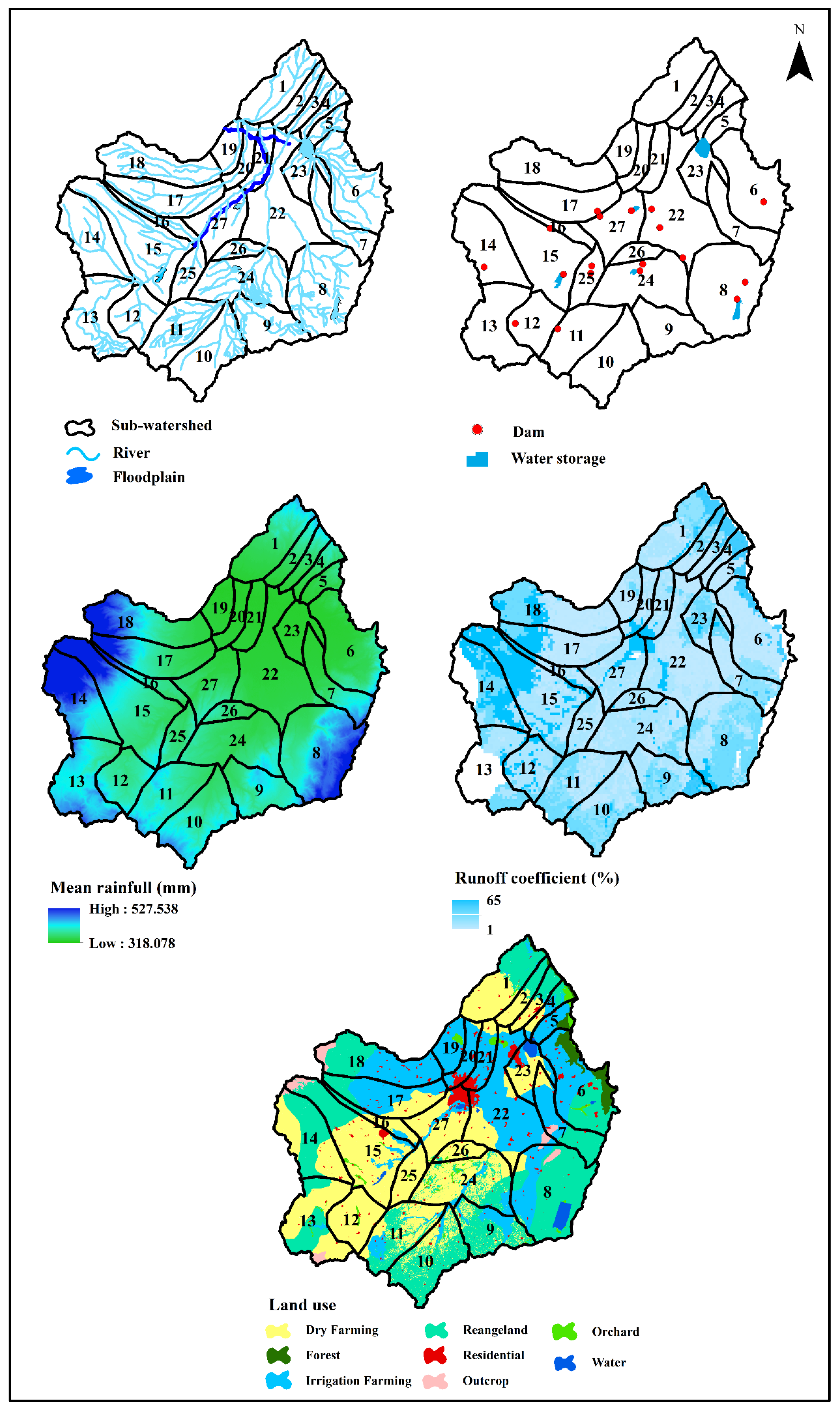
References
- Sanchez, E.F.; Alvarez, C.I. Prioritization of hydrological restoration areas using AHP and GIS in Dulcepamba River Basin in Bolivar–Ecuador. Hydrology 2024, 11, 81. [Google Scholar] [CrossRef]
- Guimaraes, L.F.; Teixeira, F.C.; Pereira, J.N.; Becker, B.R.; Oliveira, A.K.B.; Lima, A.F.; Verol, A.P.; Miguez, M.G. The challenges of urban river restoration and the proposition of a framework towards river restoration goals. J. Clean. Prod. 2021, 316, 128330. [Google Scholar] [CrossRef]
- Guimaraes, L.F.; Verol, A.P.; Miguez, M.G. Assessing urban river restoration design using an integrated economic, social and environmental index. J. Clean. Prod. 2025, 486, 144568. [Google Scholar] [CrossRef]
- Verol, A.P.; Battemarco, B.P.; Merlo, M.L.; Machado, A.C.M.; Haddad, A.N.; Miguez, M.G. The urban river restoration index (URRIX) -A supportive tool to assess fluvial environment improvement in urban flood control projects. J. Clean. Prod. 2019, 239, 114. [Google Scholar] [CrossRef]
- Verol, A.P.; Lourenço, I.B.; Fraga, J.P.R.; Battemarco, B.P.; Merlo, M.L.; Magalhães, P.C.; Miguez, M.G. River restoration integrated with sustainable urban water management for resilient cities. Sustainability 2020, 12, 4677. [Google Scholar] [CrossRef]
- Zheng, X.; Wang, F. Construction of an adaptive river-based recreational network for urban river restoration: A case study of Rencheng District, Jining City, China. J. Clean. Prod. 2022, 374, 133985. [Google Scholar] [CrossRef]
- Islam, M.B.; Tingsanchali, T. Risk assessment of river bank failure due to floods in Jamuna, Ganges and Padma Rivers in Bangladesh. Int. J. Disaster Risk Reduct. 2024, 102, 104272. [Google Scholar] [CrossRef]
- Kravčík, M.; Pokorný, J.; Kohutiar, J.; Kováč, M.; Tóth, E. Water for the Recovery of the Climate-A New Water Paradigm. Water Policy. 2007. Available online: https://static1.squarespace.com/static/538c8ae0e4b0ef2df549ab42/t/55912e08e4b03ab3a9aa5c4f/1435577864636/A+New+Paradigm+for+Water.pdf (accessed on 22 August 2024).
- Baptista, M.N.; Valcarcel, R.; Mateus, F.A.; Medeiros, W.S.; De Andrade, F.C. Impact of urbanization on the hydrodynamics of a water table in a floodplain with high potential for renaturation. Water Resour. Manag. 2017, 31, 4091–4102. [Google Scholar] [CrossRef]
- Cunha, N.S.; Magalhaes, M.R.; Domingos, T.; Abreu, M.M.; Küpfer, C. The land morphology approach to flood risk mapping: An application to Portugal. J. Environ. Manag. 2017, 193, 172–187. [Google Scholar] [CrossRef] [PubMed]
- Morandi, B.; Piegay, H.; Lamouroux, N.; Vaudor, L. How is success or failure in river restoration projects evaluated? Feedback from French restoration projects. J. Environ. Manag. 2014, 137, 178–188. [Google Scholar] [CrossRef] [PubMed]
- Mrozinska, N.; Glinska Lewczuk, K.; Burandt, P.; Kobus, S.; Gotkiewicz, W.; Szymanska, M.; Bakowska, M.; Obolewski, K. Water quality as an indicator of stream restoration effects- A Case Study of the Kwacza River restoration project. Water 2018, 10, 1249. [Google Scholar] [CrossRef]
- Williams, M.R.; Filoso, S. Changes in hydrology and pollutant loads from stream restoration in an urban headwater catchment. Hydrology 2023, 618, 129164. [Google Scholar] [CrossRef]
- Divsalar, A.; Shokri Firoozjah, P.; Ferdowsi, S. Analyzing the strategies of rehabilitation of Shahrood River by SWOT technique. J. Environ. Sci. Tec. 2016, 18, 43–65. (In Persian). Available online: https://sanad.iau.ir/en/Journal/jest/Article/839188/FullText (accessed on 22 August 2024).
- Lotfi, H.; Mousazadeh, H. Restoration of open spaces around urban rivers and their role in the quality of life and security of citizens (Case study: Alangdareh River, Gorgan). Hum. Geogr. Res. 2020, 52, 199–219. (In Persian) [Google Scholar] [CrossRef]
- Banihabib, M.E.; Ezzatiamini, M.; Shabestari, M. A framework for determining sustainable development strategy in restoring a seasonal urban river. Watershed Eng. Manag. 2019, 11, 316–327. [Google Scholar] [CrossRef]
- Naderi, M.H.; Zakerinia, M.; Salarijazi, M. Aquatic of ecosystem management and restoration rivers. Iran. J. Ecohydrol. 2019, 6, 719–737. (In Persian) [Google Scholar] [CrossRef]
- Rajabi, H.; Firoozi, M.A.; Amanpur, S.; Hasani, N. Selecting the best way to develop green water space with the approach of rehabilitation and development of urban rivers based on AHP method. Water Resour. Eng. 2021, 14, 103–116. (In Persian) [Google Scholar] [CrossRef]
- Yousefi, A. Reviving the Zayandeh Rud River: Inquiring the remained opportunities. Water Resour. Eng. 2023, 18, 179–185. (In Persian) [Google Scholar]
- Talebi, Z.; Ayyoubzadeh, S.A.; Mostafavi, H.; Hosseinzadeh, M.M.; Moghaddam, H.S. Morphological analysis and assessment of a river based on morphological characteristics, artificial structures and channel adjustments (Case study: Talar River-Upstream of Shirgah). Environ. Sci. 2024, 22, 21–38. (In Persian). Available online: https://envs.sbu.ac.ir/article_103119.html?lang=en (accessed on 22 August 2024).
- Moradzadeh, V.; Hazbavi, Z.; Esmali Ouri, A.; Mostafazadeh, R.; Zarei, S.; Alaei, N. Assessment of spatial heterogeneity of hydro-sedimentological disturbance index in the Samian sub-watersheds. Hydrogeomorphology 2022, 9, 136-117. (In Persian) [Google Scholar] [CrossRef]
- Country Planning and Budget Organization. Studies of Ardabil Province Planning and Budget Organization; Management and Planning Organization: Tehran, Iran, 2018; 195p. (In Persian)
- Statistics Center of Iran. General Census of the Population and Housing of Ardabil Province; Statistics Center of Iran: Tehran, Iran, 2016; (In Persian). Available online: https://old.sci.org.ir/english/Population-and-Housing-Censuses (accessed on 29 April 2024).
- Azizi, E.; Mostafazadeh, R.; Hazbavi, Z.; Esmali Ouri, A.; Mirzaie, S.; Huang, G.; Qian, X. Spatial distribution of flood vulnerability index in Ardabil province, Iran. Stoch. Environ. Res. Risk Assess. 2022, 36, 4355–4375. [Google Scholar] [CrossRef]
- Liu, Y.B. Development and Application of a GIS-Based Hydrological Model for Flood Prediction and Watershed Management. Ph.D. Thesis, Vrije Universiteit, Brussel, Belgium, 2024. [Google Scholar]
- Hazbavi, Z.; Alaei, N. Assessment and optimization of hydrological connectivity for effective management of water resources in the Samian Watershed. Spat. Plan. 2024, 14, 115–138. [Google Scholar]
- Hysa, A. Introducing Transversal Connectivity Index (TCI) as a method to evaluate the effectiveness of the blue-green infrastructure at metropolitan scale. Ecol. Indic. 2021, 124, 107432. [Google Scholar] [CrossRef]
- Gonzalez del Tanango, M.; García De Jalon, D. Restauracion de ríos. Guía Metodologica para la Elaboracion de Proyectos, 1st ed.; Estrategia Nacional de Restauracion de Ríos-Programa Agua: Madrid, Spain, 2007.
- Machado, A.C.M.; Verol, A.P.; Miguez, M.G. River classification index (RCI): A tool for preliminary river quality assessment considering river restoration aspects. In Proceedings of the 13th Conference on Sustainable Development of Energy, Water, and Environment Systems, Palermo, Italy, 30 September–4 October 2018; pp. 1–17. [Google Scholar]
- Wohl, E. Connectivity in rivers. Prog. Phys. Geog. 2017, 41, 345–362. [Google Scholar] [CrossRef]
- Keshavarz-Ghorabaee, M.; Amiri, M.; Zavadskas, E.K.; Turskis, Z.; Antucheviciene, J. Determination of objective weights using a new method based on the removal effects of criteria (MEREC). Symmetry 2021, 13, 525. [Google Scholar] [CrossRef]
- Shanmugasundar, G.; Sapkota, G.; Čep, R.; Kalita, K. Application of MEREC in multi-criteria selection of optimal spray-painting robot. Processes 2022, 10, 1172. [Google Scholar] [CrossRef]
- Marc Roubens, M. Preference relations on actions and criteria in multicriteria decision making. Eur. J. Oper. Res. 1982, 10, 51–55. [Google Scholar] [CrossRef]
- Yerlikaya, M.A.; Yildiz, K.; Keskin, B.N. Solution proposal for completed preference structure in ORESTE method. Sci. Rep. 2023, 13, 4754. [Google Scholar] [CrossRef] [PubMed]
- Portabari, M.M.; Banihabib, A.; Najafi Marghmaleki, S. River restoration. In Proceedings of the 4th International Conference on Planning and Management, Tehran, Iran, 23–24 May 2017. (In Persian). [Google Scholar]
- Sadeghi Ravesh, M.H. Evaluation of de-desertification in Ardakan-khezr Abad plain by using Shannon entropy method and ORESTE model. Environ. Eros. Res. 2019, 8, 19–40. (In Persian) [Google Scholar]
- Jafari, H. Identification and prioritization of grain discharging operations risks by using ORESTE method. Am. J. Public Health Res. 2013, 1, 214–220. [Google Scholar] [CrossRef][Green Version]
- Zareie, S.; Hazbavi, Z.; Mostafazadeh, R.; Esmali Ouri, A. Vulnerability comparison of Samian sub-watersheds based on climate change components. Phys. Geogr. Res. 2021, 52, 217–236. (In Persian) [Google Scholar] [CrossRef]
- Mostafazadeh, R.; Mehri, S. Comparing the variations in hydrologic response of Ardabil Province watersheds using precipitation-runoff polygons. Watershed Eng. Manag. 2019, 11, 381–391. (In Persian) [Google Scholar] [CrossRef]
- Rasinezami, S.; Izadifard, H.; Mostafazadeh, R.; Khavarian, H. Urban Development and the Characteristics of Hort and Medium-Term Hydrological Drought in the Samian Watershed of Ardabil Province. Geography Urban and Regional Studies. 2023. (In Persian). Available online: https://sanad.iau.ir/en/Journal/ges/Article/699059?jid=699059 (accessed on 24 August 2024).
- Raoof, M.; Alioghli, S. Estimation of environmental flow of the Balikhlochai River and evaluation impact of Yamchi dam operation on hydrological and environmental regime of the river. J. Nat. Environ. 2020, 73, 299–312. [Google Scholar] [CrossRef]
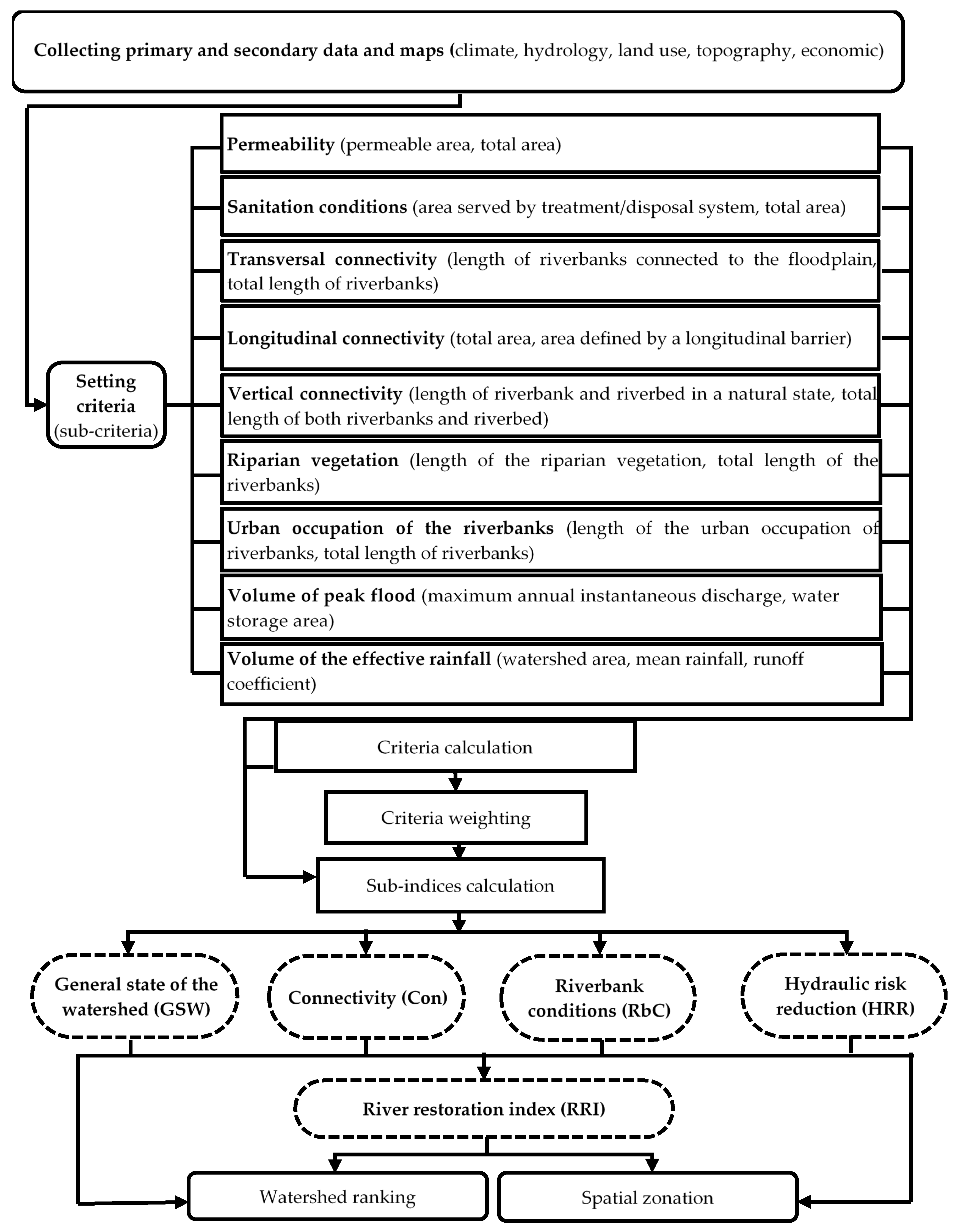
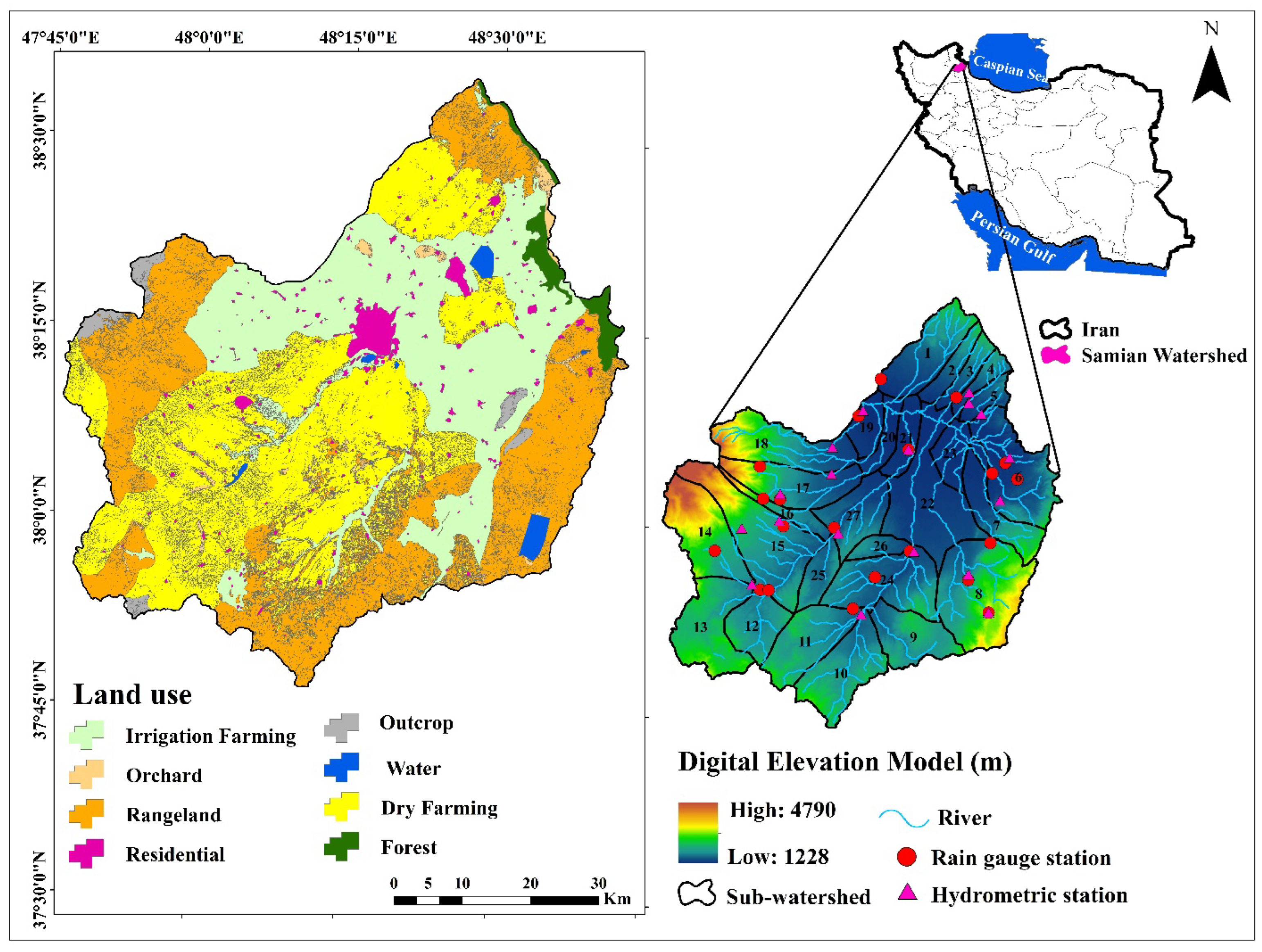
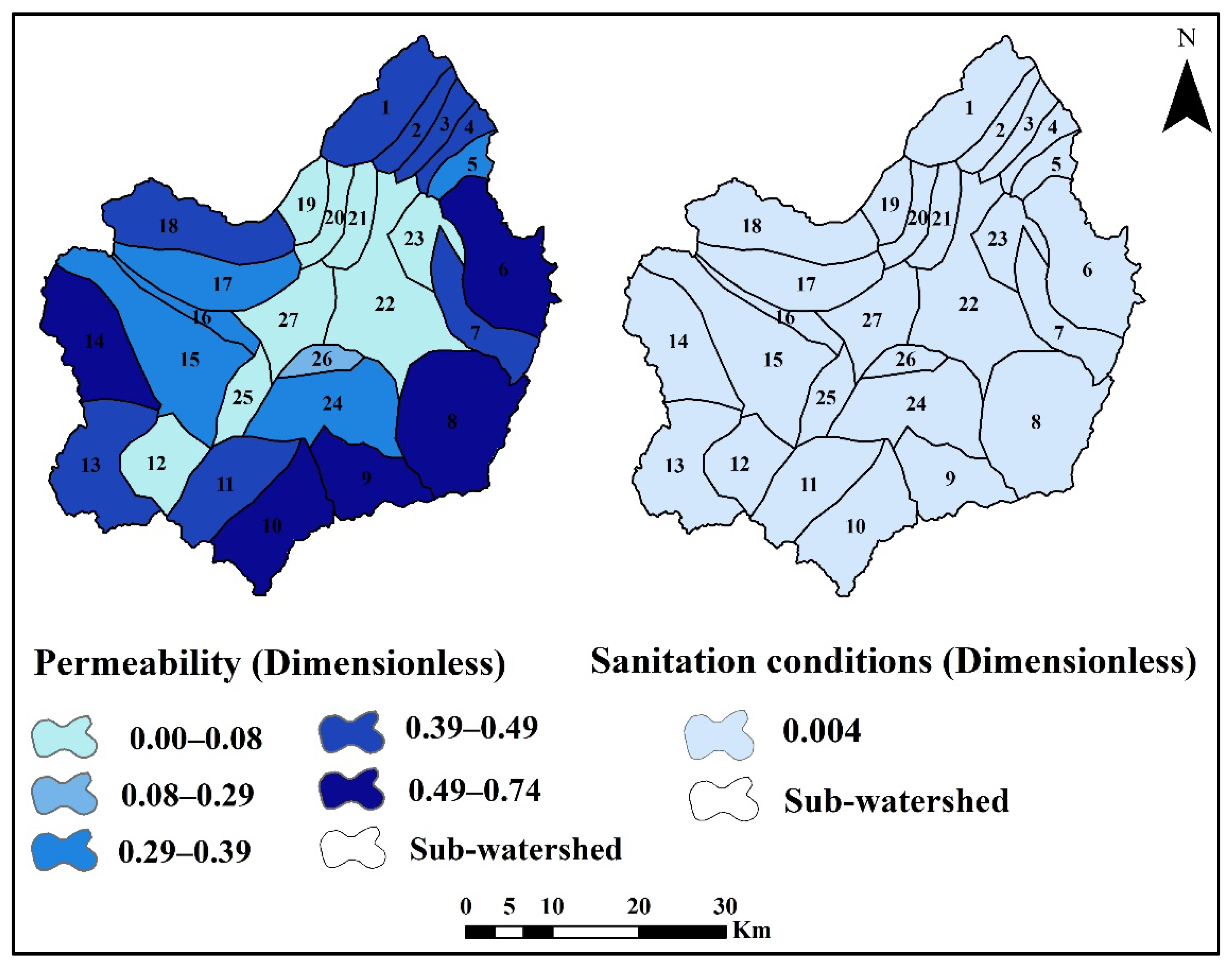

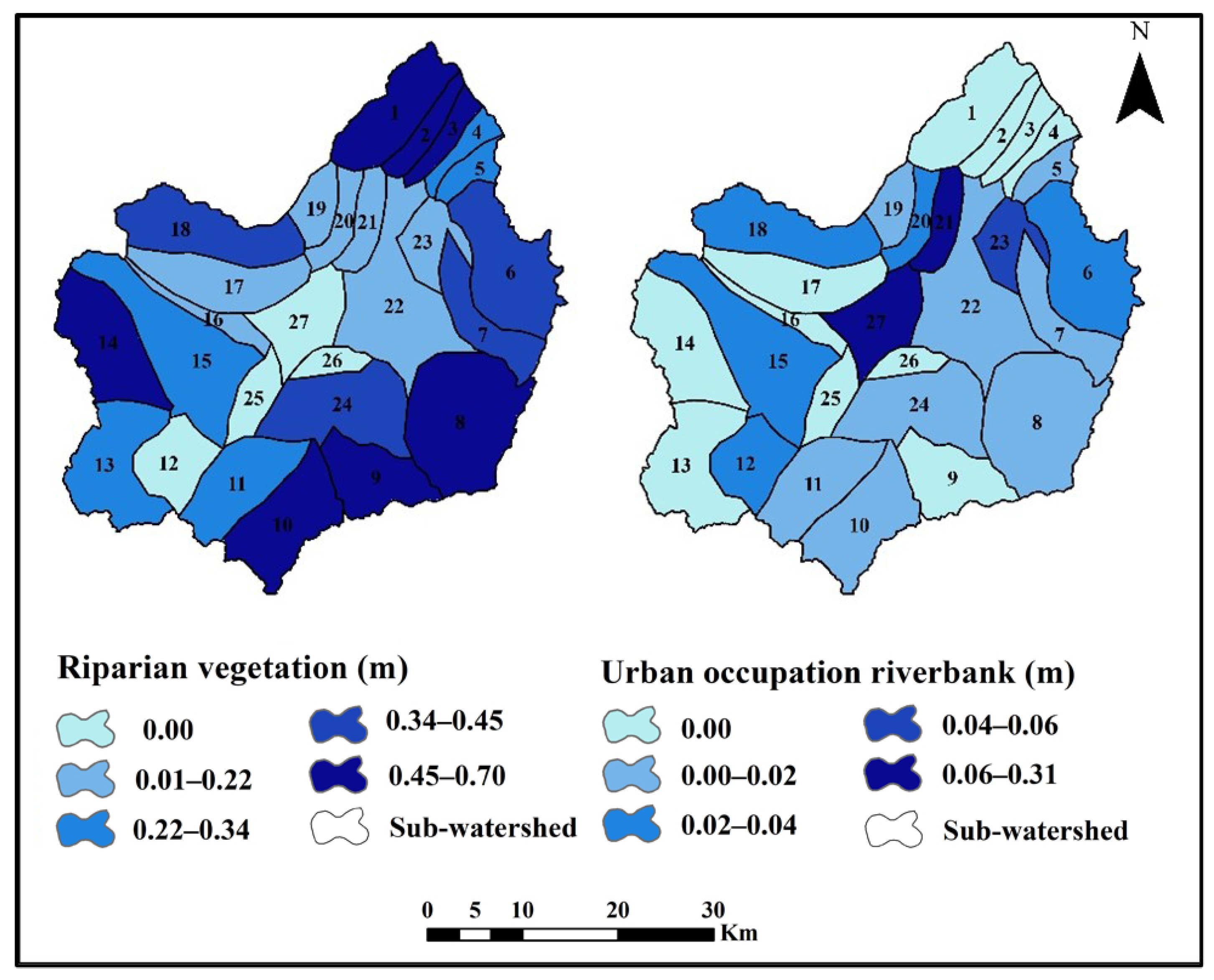
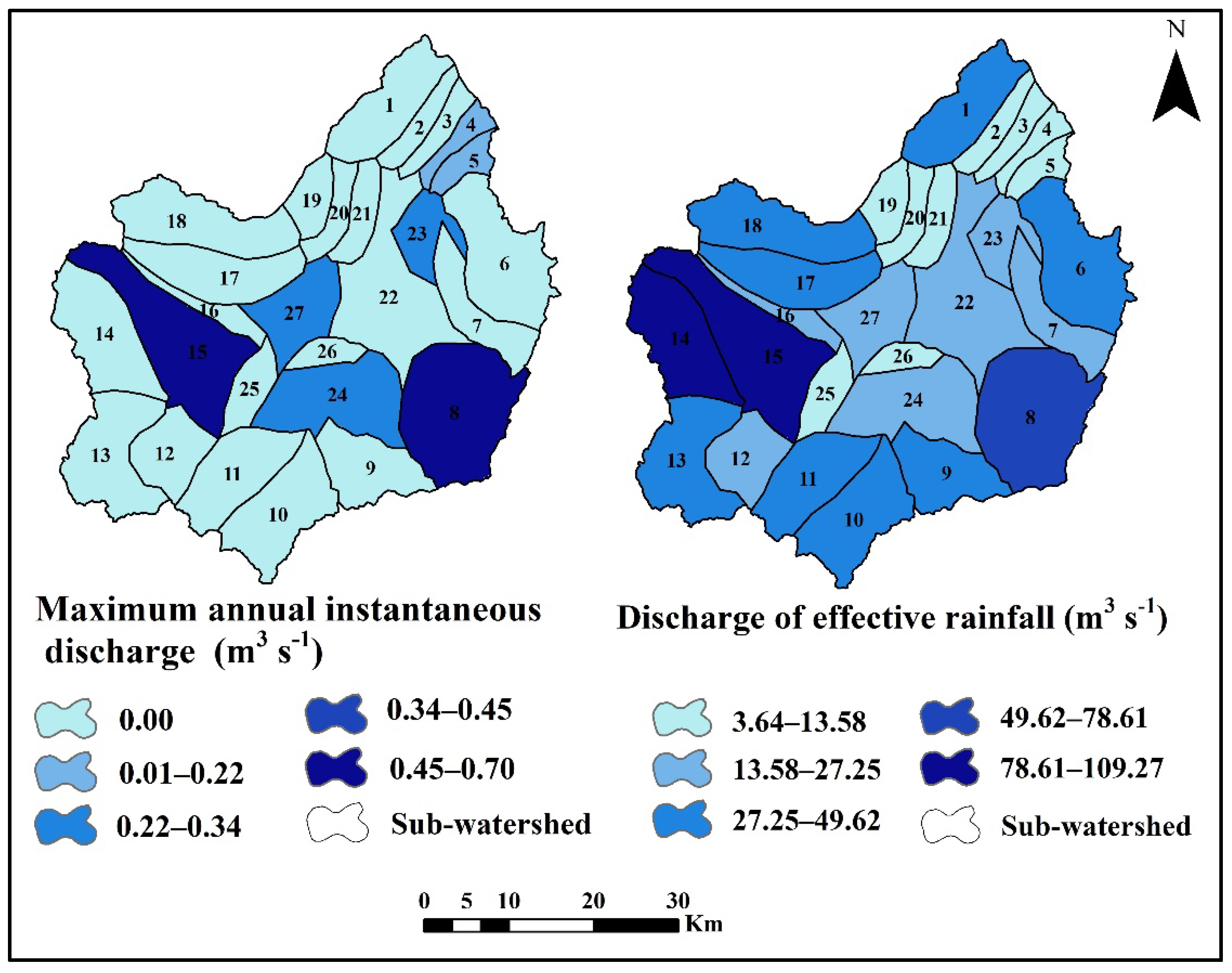
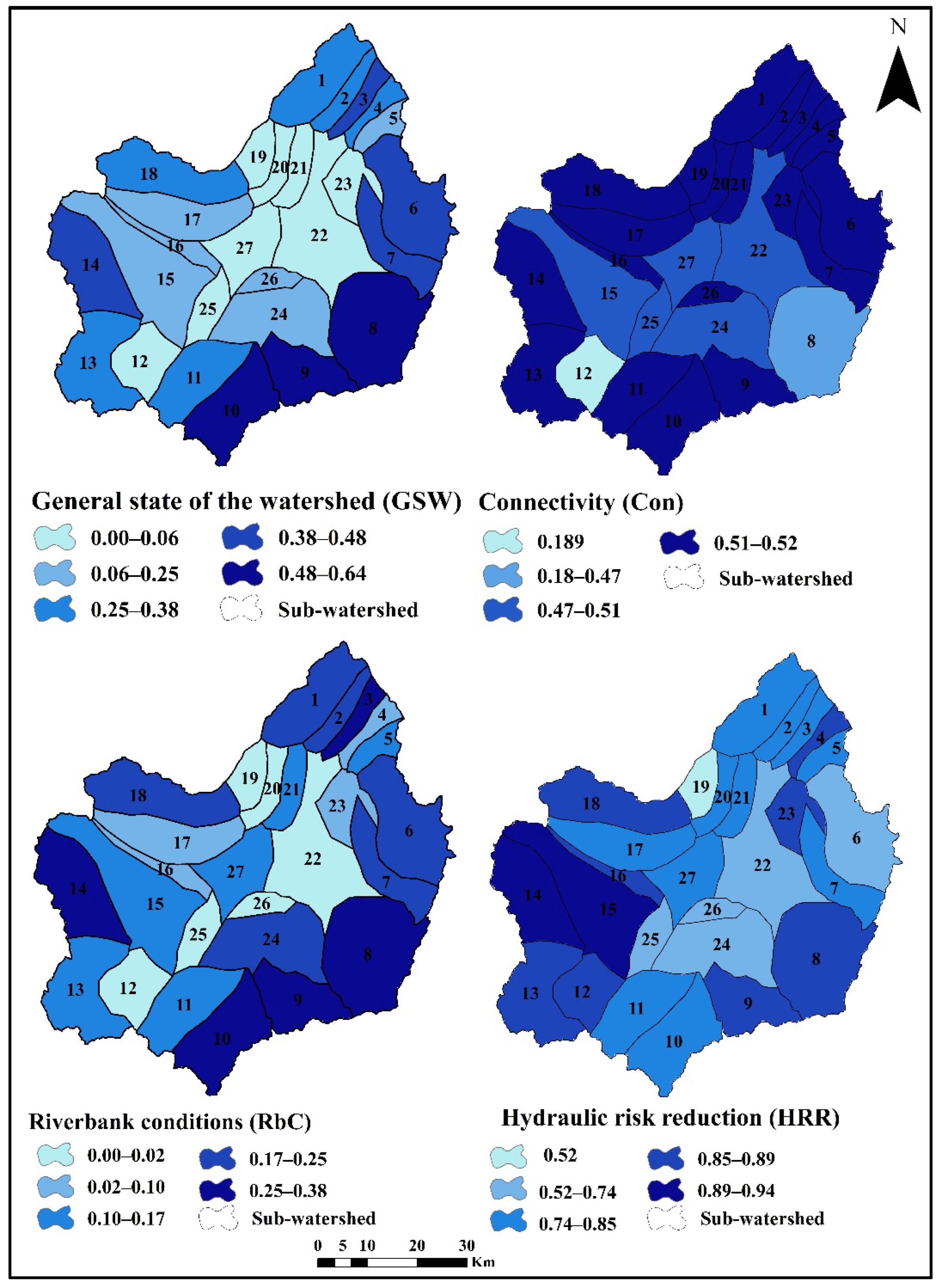
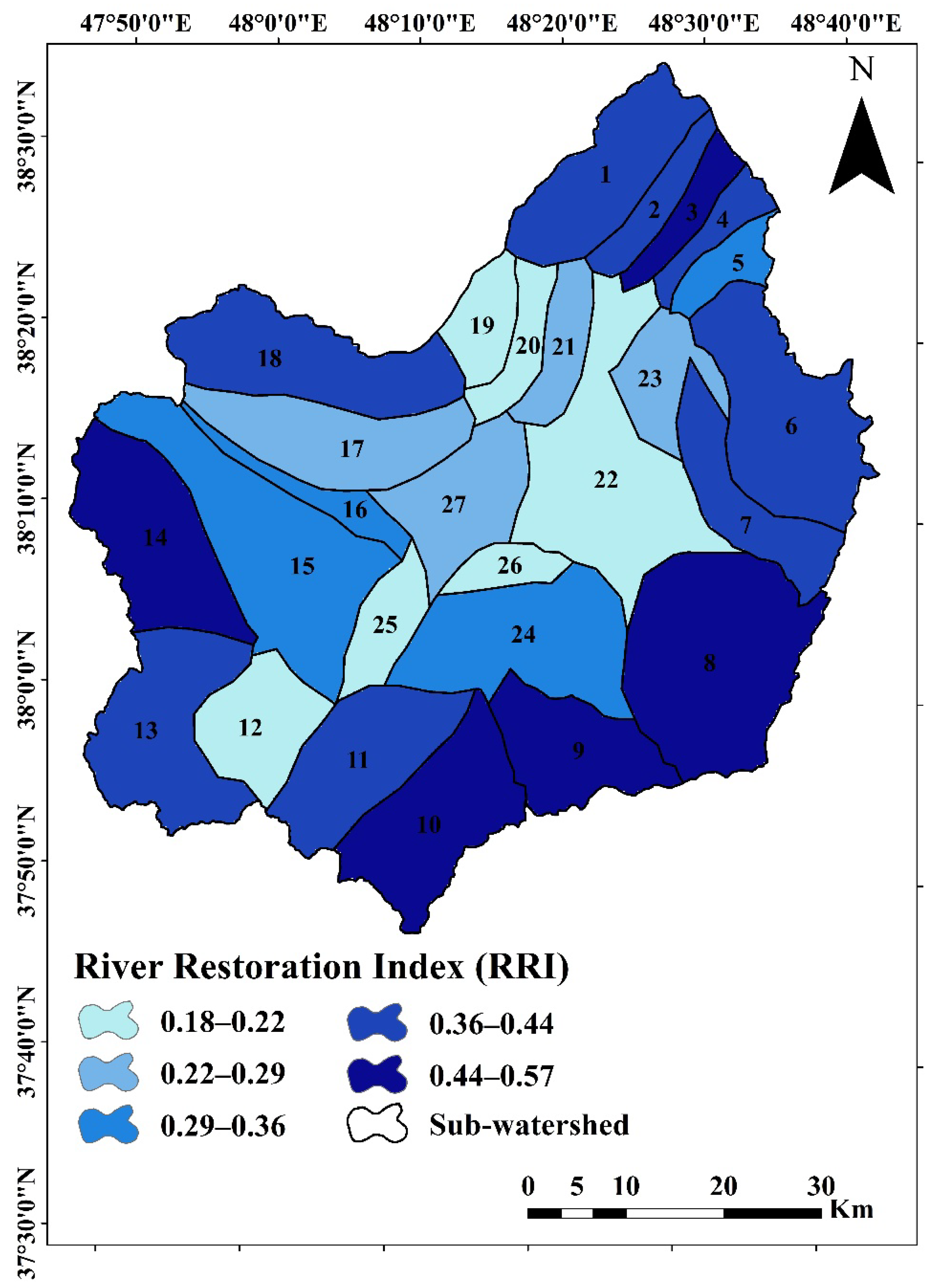
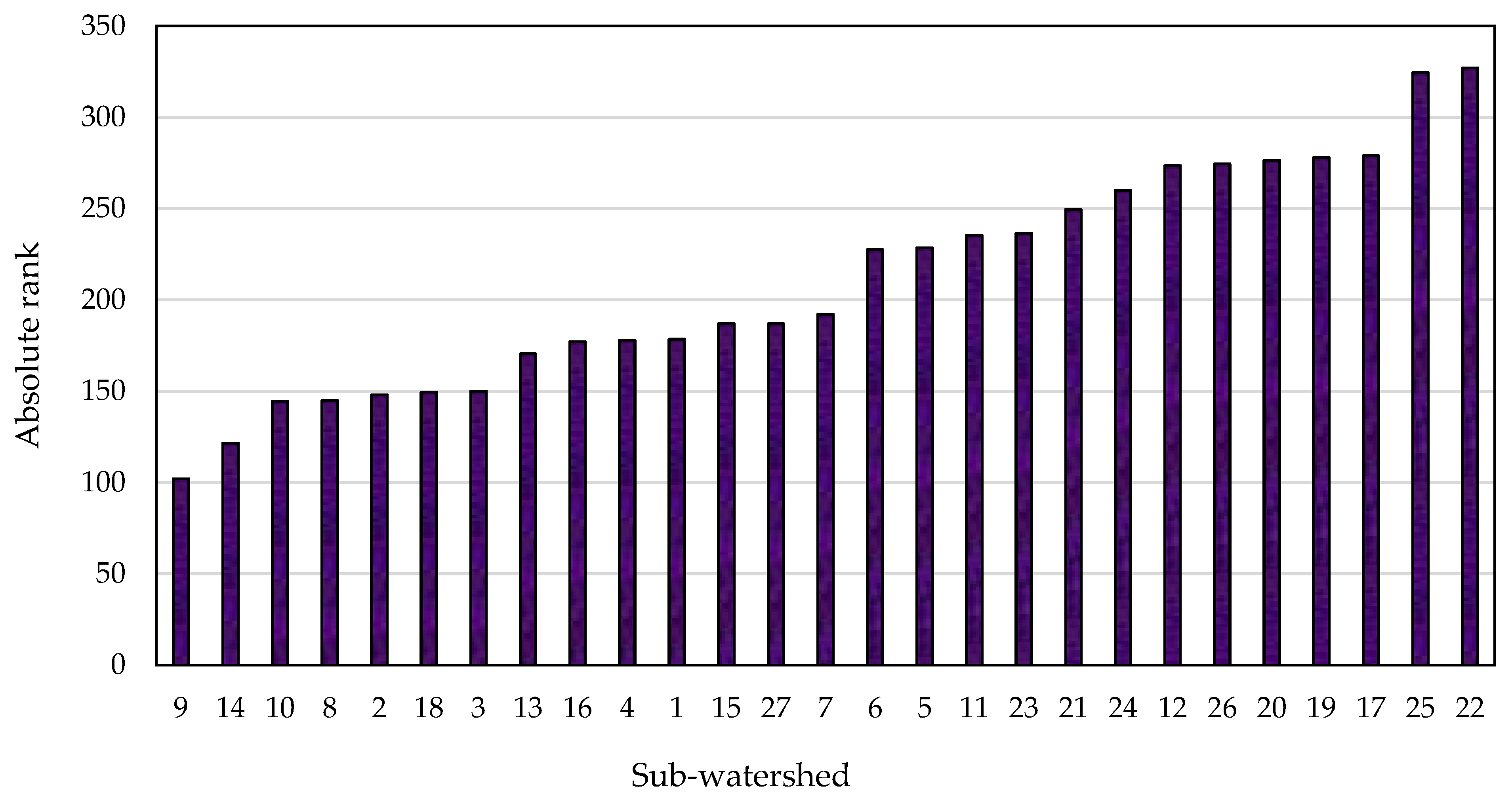
| Sub-Indices | General State of the Watershed (GSW) | Connectivity (Con) | Riverbank Conditions (RbC) | Hydraulic Risk Reduction (HRR) | ||||
|---|---|---|---|---|---|---|---|---|
| Weight | 0.36 | 0.16 | 0.32 | 0.16 | ||||
| Criteria | Permeability | Sanitation conditions | Transversal | Longitudinal | Vertical | Riparian vegetation | Urban occupation of the riverbanks | - |
| Weight | 0.88 | 0.12 | 0.48 | 0.37 | 0.15 | 0.54 | 0.46 | - |
| Sub-Watershed No. | General State of the Watershed (GSW) | Absolute Rank * | Connectivity (Con) | Absolute Rank | Riverbank Conditions (RbC) | Absolute Rank | Hydraulic Risk Reduction (HRR) | Absolute Rank | River Restoration Index (RRI) | Absolute Rank |
|---|---|---|---|---|---|---|---|---|---|---|
| 1 | 0.36 | 16.5 | 0.50 | 62.0 | 0.24 | 23.5 | 0.85 | 76.5 | 0.42 | 178.5 |
| 2 | 0.37 | 14.5 | 0.50 | 62.0 | 0.25 | 20.0 | 0.86 | 51.5 | 0.43 | 148.0 |
| 3 | 0.43 | 10.0 | 0.50 | 62.0 | 0.33 | 6.5 | 0.86 | 71.5 | 0.48 | 150.0 |
| 4 | 0.38 | 13.5 | 0.50 | 62.0 | 0.10 | 71.5 | 0.88 | 31.0 | 0.39 | 178.0 |
| 5 | 0.23 | 25.5 | 0.50 | 62.0 | 0.12 | 53.0 | 0.82 | 88.0 | 0.33 | 228.5 |
| 6 | 0.50 | 6.5 | 0.50 | 95.5 | 0.20 | 34.5 | 0.75 | 91.0 | 0.44 | 227.5 |
| 7 | 0.39 | 12.0 | 0.50 | 62.0 | 0.22 | 31.0 | 0.82 | 87.0 | 0.42 | 192.0 |
| 8 | 0.58 | 2.5 | 0.46 | 106.0 | 0.30 | 16.5 | 0.88 | 20.0 | 0.52 | 145.0 |
| 9 | 0.56 | 4.5 | 0.50 | 62.0 | 0.32 | 10.0 | 0.88 | 25.5 | 0.53 | 102.0 |
| 10 | 0.65 | 1.0 | 0.50 | 62.0 | 0.38 | 2.5 | 0.85 | 79.0 | 0.57 | 144.5 |
| 11 | 0.33 | 20.0 | 0.50 | 92.0 | 0.17 | 42.0 | 0.84 | 81.5 | 0.39 | 235.5 |
| 12 | 0.02 | 38.5 | 0.20 | 107.0 | 0.01 | 80.0 | 0.87 | 48.0 | 0.18 | 273.5 |
| 13 | 0.30 | 22.0 | 0.50 | 62.0 | 0.13 | 50.0 | 0.88 | 36.5 | 0.37 | 170.5 |
| 14 | 0.45 | 8.0 | 0.50 | 95.5 | 0.32 | 13.5 | 0.95 | 4.5 | 0.50 | 121.5 |
| 15 | 0.22 | 29.0 | 0.49 | 103.0 | 0.15 | 45.0 | 0.92 | 10.0 | 0.35 | 187.0 |
| 16 | 0.22 | 27.5 | 0.50 | 62.0 | 0.08 | 73.0 | 0.89 | 14.5 | 0.33 | 177.0 |
| 17 | 0.15 | 31.0 | 0.50 | 99.0 | 0.07 | 75.0 | 0.85 | 74.0 | 0.29 | 279.0 |
| 18 | 0.34 | 18.0 | 0.50 | 62.0 | 0.22 | 27.5 | 0.88 | 42.0 | 0.41 | 149.5 |
| 19 | 0.05 | 34.5 | 0.50 | 62.0 | 0.01 | 81.5 | 0.52 | 100.0 | 0.18 | 278.0 |
| 20 | 0.001 | 46.5 | 0.50 | 62.0 | 0.02 | 78.0 | 0.78 | 90.0 | 0.21 | 276.5 |
| 21 | 0.04 | 36.5 | 0.50 | 62.0 | 0.12 | 62.0 | 0.81 | 89.0 | 0.26 | 249.5 |
| 22 | 0.01 | 42.0 | 0.49 | 104.0 | 0.004 | 83.0 | 0.67 | 98.0 | 0.19 | 327.0 |
| 23 | 0.001 | 46.5 | 0.50 | 62.0 | 0.03 | 76.5 | 0.86 | 51.5 | 0.23 | 236.5 |
| 24 | 0.25 | 23.5 | 0.49 | 105.0 | 0.17 | 38.5 | 0.73 | 93.0 | 0.34 | 260.0 |
| 25 | 0.02 | 40.0 | 0.49 | 102.0 | 0.00 | 85.5 | 0.68 | 97.0 | 0.19 | 324.5 |
| 26 | 0.07 | 33.0 | 0.50 | 62.0 | 0.00 | 85.5 | 0.68 | 94.0 | 0.21 | 274.5 |
| 27 | 0.006 | 44.0 | 0.49 | 10.0 | 0.14 | 49.0 | 0.83 | 84.0 | 0.26 | 187.0 |
Disclaimer/Publisher’s Note: The statements, opinions and data contained in all publications are solely those of the individual author(s) and contributor(s) and not of MDPI and/or the editor(s). MDPI and/or the editor(s) disclaim responsibility for any injury to people or property resulting from any ideas, methods, instructions or products referred to in the content. |
© 2025 by the authors. Licensee MDPI, Basel, Switzerland. This article is an open access article distributed under the terms and conditions of the Creative Commons Attribution (CC BY) license (https://creativecommons.org/licenses/by/4.0/).
Share and Cite
Hazbavi, Z.; Azizi, E.; Ghabelnezam, E.; Sharifi, Z.; Davudirad, A.; Fathololoumi, S. Enhancing Watershed Management Through the Characterization of the River Restoration Index (RRI): A Case Study of the Samian Watershed, Ardabil Province, Iran. Earth 2025, 6, 6. https://doi.org/10.3390/earth6010006
Hazbavi Z, Azizi E, Ghabelnezam E, Sharifi Z, Davudirad A, Fathololoumi S. Enhancing Watershed Management Through the Characterization of the River Restoration Index (RRI): A Case Study of the Samian Watershed, Ardabil Province, Iran. Earth. 2025; 6(1):6. https://doi.org/10.3390/earth6010006
Chicago/Turabian StyleHazbavi, Zeinab, Elham Azizi, Elnaz Ghabelnezam, Zahra Sharifi, Aliakbar Davudirad, and Solmaz Fathololoumi. 2025. "Enhancing Watershed Management Through the Characterization of the River Restoration Index (RRI): A Case Study of the Samian Watershed, Ardabil Province, Iran" Earth 6, no. 1: 6. https://doi.org/10.3390/earth6010006
APA StyleHazbavi, Z., Azizi, E., Ghabelnezam, E., Sharifi, Z., Davudirad, A., & Fathololoumi, S. (2025). Enhancing Watershed Management Through the Characterization of the River Restoration Index (RRI): A Case Study of the Samian Watershed, Ardabil Province, Iran. Earth, 6(1), 6. https://doi.org/10.3390/earth6010006







